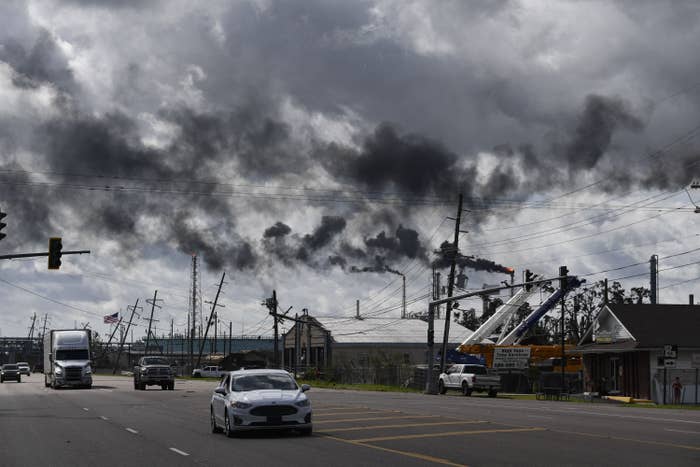
Toxic flares from Shell chemical plant in Louisiana
From an Article by Zahra Hirji, BuzzFeed News, September 2, 2021
A massive Royal Dutch Shell manufacturing complex in Louisiana’s St. Charles Parish is releasing nonstop plumes of smoke into the air after Hurricane Ida knocked out its power. Local, state, and federal officials are monitoring the incident.
The plumes of smoke at Shell’s Norco plant are just one of a growing number of sources of industrial pollution slowly coming into view across the Gulf Coast following the Category 4 hurricane’s devastating blow to the region.
At this point, Shell is not saying much about the problems plaguing the Norco facility, one of the largest petrochemical plants in the country. “While the site remains safe and secure, we are experiencing elevated flaring,” Curtis Smith, a Shell spokesperson. “We expect this to continue until power is restored.”
When it’s up and running, Shell’s combined refinery and chemical plant in Norco processes about 250,000 barrels of crude oil and 170,000 barrels of gasoline a day, in addition to generating billions of pounds of ethylene, propylene, and other chemicals. Like other refineries and industrial sites along the Gulf Coast, Shell shut down the plant ahead of Ida’s landfall.
Industrial sites often spew dirty gases into the air during emergency shutdowns and restarts, threatening nearby communities with smog and other pollution that can make it hard for people to breathe. Back in 2017, Hurricane Harvey led to Texas chemical and petroleum plants releasing a year’s worth of pollution in a matter of days and weeks.
According to Shell’s Norco permit, some flaring in emergency situations is allowed, but it’s unclear whether the current emission levels exceed what’s allowable under the permit. “Shell Norco is flaring,” said Gregory Langley, press secretary of Louisiana’s Department of Environmental Quality, “When there is an emergency condition, they are allowed to do this under their permit.”
That being said, Langley added, “The flares at Shell Norco are large and produce some smoke.” Starting Thursday, Louisiana’s environmental officials will monitor Norco’s air quality using what’s called a Mobile Air Monitoring Laboratory.
The Environmental Protection Agency is also sending a special plane to help monitor local air emissions in Norco, agency press secretary Nick Conger said. EPA has received reports of the facility flaring four types of noxious gas: butadiene, benzene, hydrogen sulfide, and hydrogen, Conger added.
“Excessive smoke seen in the community is a result of a lack of electricity” at the plant, EPA officials wrote in an incident summary posted online Wednesday afternoon.
They noted that Shell is conducting its own air monitoring along the Norco fence line and in the surrounding community, reporting that information to emergency officials in St. Charles Parish, and company engineers “are looking at all options to try to reduce emissions to flare.”
Norco residents say the current flaring levels aren’t normal. “This is bad,” Norco resident Peter Anderson told DeSmog. “I have never seen this many flares.”
Beyond Norco, Shell is still assessing whether Ida damaged a chemical plant in Geismar, Louisiana, as well as any of the company’s floating platforms and other infrastructure used for extracting fossil fuels offshore in the Gulf of Mexico.
Ongoing power outages, widespread storm debris, and impassable roads are complicating the ability of companies and government officials to quickly identify environmental impacts, such as emission releases and spills, triggered by the storm.
At least 138 major industrial sites are located in parishes hit hard by Ida, according to the New York Times. As of Wednesday afternoon, the EPA had received 28 reports of possible spills and pollution events in places hit by Ida, including 17 possible air pollution incidents. None of them have so far required the EPA to do on-the-ground assessments.
Meanwhile, the Associated Press reported on Wednesday that there’s a mileslong black slick of oil near an oil rig in Gulf waters. The spill was identified using aerial imagery.
#######……………………#######……………………#######
See also: Odor reported in Pittsburgh coming from Neville Chemical Company, WTAE News 4, Allegheny County, PA, September 2, 2021
PITTSBURGH — Allegheny County Emergency Dispatchers received numerous reports of a strong odor across the Pittsburgh area Thursday morning. Dispatchers told Pittsburgh’s Action News 4 that the source of the smell is the Neville Chemical Company at Neville Island, a producer of hydrocarbon resins.
The Allegheny County Health Department released the following statement:
“The Allegheny County Health Department is aware of a strong odor being reported by residents primarily in McKees Rocks and other nearby areas. The odor was first reported around 4:30 AM and was immediately investigated by the county Emergency Management Agency. The odor appears to be the result of a weather inversion. The Health Department continues to monitor air quality in the area and will provide updates when available.”
Officials said the odor does not pose any risk and is just an irritant.
The vice president of manufacturing for Neville Chemical Company, Dan Kokoski, said the plant had an incident with one of the packaging vessels and a chemical was released that has a sweet hydrocarbon type odor. He also said the smell didn’t match up to what some people reported, so they are working with the health department to figure out if the smell came from the plant.
